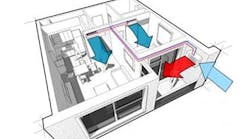BY JIM CROWDER
Editor's Note: This is the introduction to a series of indoor air quality (IAQ) business "how-to" articles from HVAC contractors of all sizes throughout North America. In these articles, you'll get practical insight on the best practices for capturing your share of the lucrative IAQ market and continually growing and improving your own IAQ business whatever your own company's size, type, or location.
Figure 1. Once companies commit to IAQ, it makes up an increasing percentage of their revenue.
Figure 2. IAQ problems are more prevalent than temperature and humidity problems.
Figure 3. We have effective solutions to offer to our customers . . .
Figure 4. . . . and there's no shortage of customers whose homes need IAQ solutions
What's in it for my company, my customers, and me?
That's the bottom-line question every contractor asks him or herself whenever it comes time to make a decision about investing in new programs or equipment. In fact, that question is more than just bottom line — it's plain good business sense. Every week there's a payroll to make and payments to meet, and any investment, whether it's in your people, product, or programs, must pull its weight.
Indoor air quality (IAQ) is a hot topic. IAQ has been on the scene for decades, but over the past couple of years, it has been receiving a great deal of new attention. Early movers on the "new IAQ scene" have led the way and shown us that the talk about the substantial business growth possible through IAQ is a reality, not just talk (see Figure 1). Research done by AirAdvice in 2005 found that a typical company that's not focusing on IAQ sees just under 3% of its total revenue coming from IAQ-related products and services. Within one year of a company choosing to focus on IAQ, that number increases to an average of 10% of revenues — and it's coming at higher margins. After a few years, contractors can collect 20% or more of their revenue from IAQ.
IAQ successes are happening for HVAC businesses of every size, in all kinds of locations and situations. IAQ is not just a "city" or "big contractor only" ticket. As the early movers already know, people everywhere want to be sure they're breathing clean air inside their homes and businesses.
"With IAQ, we talk about everything in terms of health, comfort, and safety for our customers," says Joe Zettel of Advanced Energy Concepts Inc., Lannon, WI. "For us, that's the best part, because that's what my business is all about — the customer."
IAQ is a health and comfort issue that takes you beyond traditional heating and cooling solutions. In fact, particle allergen and chemical pollutant problems are far more common than temperature or humidity problems (see Figure 2). Most significantly, contractors are beginning to use ventilation as a solution based on carbon dioxide (CO2) and volatile organic compound (VOC) measurements in markets that have not normally installed residential ventilation (see Figure 3).
The average sale for contractors using ventilation solutions has consistently been more than $2,600. If you're not tapping into IAQ, you're missing a large chunk of potential sales that not only increase your bottom line, but also help your customers live more comfortable, healthier lives.
"Customers are more and more educated about indoor air quality," says Bill Kennihan, owner of Kennihan Heating & Air Conditioning, Pittsburgh, PA. "Measuring the home-owner's indoor air quality shows them if there's a problem. Then, it's easy for us to propose a solution."
There are realities to entering the IAQ business and claiming your piece of this market. But it's easier than you might think, if you're willing to take the steps that get the results.
Step Up: The Need is Big and Getting Bigger
It's a fact: dirty air makes us sick. Your customers — our friends, families, and neighbors — are often breathing polluted indoor air on a daily basis, and many of them don't even know it.
Every 20 seconds, someone in the world dies due to poor indoor air quality (World Health Organization, 2005). Each day, 14 people die from asthma, a rate that has increased by more than 50% across all age, ethnic, and gender groups since 1980 (Centers for Disease Control, 2001). And many of those are children — more than 30% of the 20 million Americans with asthma are under age 18 (American Lung Association, 2003).
These statistics are just the tip of a very big iceberg. According to the Environ-mental Protection Agency (EPA), indoor air is typically five times more polluted than outdoor air. Combine that with the fact that Americans typically spend 90% of their time indoors, you can see that we've all got a real problem on our hands.
HVAC professionals are the front line of defense. You visit thousands of homes daily. You see the problems first hand. Your customers count on you to make sure the system is safe, running properly, and to point out ways it could be better.
Every HVAC contractor of any size or location has the equipment solutions on hand to address IAQ problems. And we know those problems are out there. Of more than 30,000 homes and business tested in 2004-2005, 96% had at least one IAQ problem. Eight out of ten had at least two IAQ problems (see Figure 4).
Your customers are concerned about their health and comfort, and you have the solutions. With growing consumer awareness and the effectiveness of whole-home solutions, it's no wonder that contractors are embracing IAQ as a high-growth opportunity.
"IAQ isn't rocket science," says Robert Stengel at Alamo Air in Corpus Christi, TX. "I'm just helping customers get what they want and I get the business. It's a win-win for everyone."
Gaining the Confidence to Succeed
So why aren't larger numbers of contractors succeeding in the IAQ market? The answer is primarily because the industry lacks confidence. Specifically, it's the confidence that you can accurately identify and solve your customer's problems.
What we've found is that, to be successful in IAQ, contractors must make the invisible, visible. When you install an AC system and a thermostat, the customer presses a button and gets immediate gratification — the air gets noticeably cooler. The components that determine the quality of indoor air are more difficult to detect without testing. Without objective testing, it can be tough to define a problem, difficult to design the correct solution, and even more difficult to prove that your solution is working.
Confidence is the number one obstacle to success in IAQ, but it's easy to gain that confidence. The IAQ testing equipment, reporting systems, and perhaps most importantly, the training for your employees to give your customers the clear, simple IAQ information they need all exist. Giving yourself and your team a series of positive experiences successfully finding and fixing IAQ issues in your own homes and customers' homes gains you that necessary confidence.
Rick Hendrickson, a comfort advisor at JL Patterson Heating and Cooling, Charlotte, NC, shares that view. "Customers respond well to IAQ. Now that we're out there with the confidence to diagnose it, we're closing jobs where we're coming in as the highest bid because the customer understands what we're offering and why."
Test, Don't Guess
Joe Wadas, owner of Wadas Inc. in Ord, NE, says it short and sweet: "Measurement takes the guesswork out of IAQ."
This is no big surprise to an industry that has used gauges, meters, and other measurement devices for decades to evaluate and fix heating and cooling systems. Like any other issue in the home, measuring IAQ parameters allows you to pinpoint issues with precision. It's one more tool for the kit — sharing results with your customer shows them how their daily lives impact their IAQ. With this information in hand, both you and your customer can be confident in the proposal you present.
Confidence is the foundation to a healthy IAQ business. If you believe, you will act — and when you can see a problem with an IAQ test, you will have no trouble believing and neither will your customers.
You've Got Solutions, Retailers Don't
"We got a call from a homeowner who was getting bids for some work on his home," says Jim Bonniwell, owner of Liberty Heating and Air Conditioning, Anoka, MN. "We offered to do IAQ testing. When we showed the results to the customer, we got the job right there. The wife said, 'Let's just stop thinking about it and go ahead and do it.' We closed a big sale, but also made these customers so happy, they're now sending other people to us."
Bonniwell's experience could be any contractor's experience. It all starts and ends with the customers in their home. Unlike retail sales people who will never set foot in their customers' homes, you are loyal and committed to your customers. You care about their comfort and safety, and in contrast to ineffective in-room air cleaners (Consumer Reports, 2004), your solutions actually achieve what your customers are looking for: cleaner, healthier air throughout the whole home (Mayo Clinic Study, 1999).
Who Deserves Healthy Air?
Ask yourself and ask each one of your employees: "Which one of our customers is entitled to breathe clean, healthy air?" Of course the response is always, "all of them."
IAQ is not about focusing on some "billion dollar opportunity." What it comes down to for our industry is what matters most: taking care of our customers, one at a time. In order to accomplish this, you have to set goals for yourself and your team. You grow and develop that team, provide them with incentives, use products that really help your customers, test when appropriate, understand the issues, and measure the results.
There is not a "one size fits all" IAQ product that fixes every possible problem. Many homes need filtration; many need ventilation or humidity control. But we don't use a "one size fits all" approach for heating and cooling, either. All it takes with IAQ is a level of confidence in knowing that you've got the solutions on hand to fix the IAQ problems you may find, same as you do when you find problems with heating or cooling.
Your customers are counting on you to be the one to let them know not just when something's wrong, but also, when something could be better. They need their HVAC contractor to ensure their families are breathing air that is healthy, safe, and comfortable and that their systems are running efficiently. Let's be there for them on all counts.
Jim Crowder is CEO of AirAdvice, Inc. Headquartered in Portland, OR, AirAdvice developed its HVAC-IAQ™ program to enable HVAC contractors to successfully diagnose indoor air quality problems and recommend the correct filtration, ventilation, humidification, and heating and cooling solutions. Crowder can be reached at 503/803-1493, e-mail [email protected]













